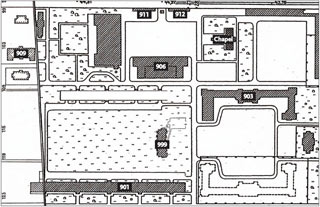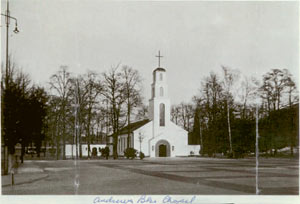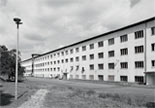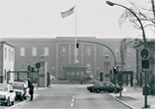
On 25 April 1945, the Red Army reached Berlin-Lichterfelde. They occupied the damaged barracks and removed the Reichs eagle with swastika from the roof of the facilities building.
Because Lichterfelde was part of the American Sector, the grounds were given over to the US troops during a festive celebration on 4 July 1945. The grounds would once again be used as barracks. Shortly thereafter, both of the "Reichsrottenführer" figures at the main entrance were encased in concrete.
The ravages of the war left its mark on the buildings. The Steglitz district's damage assessment from March 1947 declared the headquarters and the southern part of the facilities building as "severely damaged". The Officers' Club and both of the western barracks were also unusable and were considered "more than half destroyed".
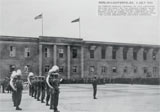
The southern part of the facilities building was deemed as "severely damaged". The northern part facing Finckensteinallee was considered as "more than half in good condition" after the war. This is a photo of the occupation ceremony with the American band in the foreground.
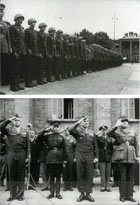
The Red Army handed over the grounds to the US forces on 4 July 1945, in the presence of representatives from all four occupying forces.
The eastern barracks were deemed as "more than half in good condition". The northern part of the facilities building and the classroom building were also considered "more than half in good condition", as was the northeast barracks, the Commander's and Administrator's houses, as well as the storage building on the corner of Finckensteinallee and Thekastraße. The tower buildings on Finkensteinallee, the indoor swimming pool and the former field hospital area were classified as "mostly or completely in good condition".
After the overhaul of the slightly damaged buildings in 1946, there were mostly logistical units of the Berlin Brigade as well as the Military Police and Pioneer units stationed on the grounds. The military band later found lodging in the former hospital building, which was later given the number 909 by the US Army when it labeled all the buildings with numbers.
Starting in 1947 the barracks were officially called "Andrews' Barracks", named after General Maxwell Andrews, the commander of the US forces in Europe killed in an accident in May 1943.
The central outside stairs on the former facilities building (Building 906) were probably added in 1950, which at the time housed the Andrews Highlight Service Club. Larger structural changes started in 1951, when the classroom building of the former Kadettenanstalt, the headquarters and the western barracks were demolished in order to make room for two new barracks as well as for Building 901.
In the same year work began on the new church, Andrews' Chapel, which opened in 1952.
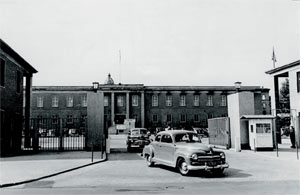
Both "Reichsrottenfuehrer" figures at the main entrance were covered with concrete soon after the war had ended. Behind the facilities building the church cupola of the destroyed headquarters, which was torn down in 1951, can be seen. Starting in 1947 the barracks were officially named "Andrews' Barracks".
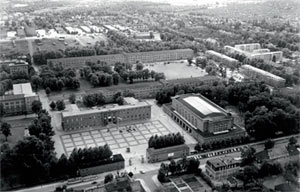
Aeriel view of Andrews' Barracks. Behind the facilities building are the two new barracks-Buildings 901 and 904. In the upper left, two blocks of housing for noncommissioned officers and their families on Baseler Straße can be seen.
In December of 1951, the west wing of the northeastern barracks (Building 903), dating from the time of the Kadettenanstalt, was destroyed by fire. It was torn down in 1953 and rebuilt in 1957. In 1958 two blocks of housing for noncommissioned officers and their families were built on Baseler Straße, and between 1959 and 1964 today's Building 999 was built as housing for unmarried, high-ranking noncommissioned officers.
After the Berlin Wall was erected in 1961, President Kennedy ordered an increase of US forces in Berlin. In addition to the 1,500 man strong Addition Battle Group, which was housed in Lichterfelde until 1964, intelligence soldiers of the Field Station Berlin now made up the majority of Andrews' Barracks troops.
Further building and demolition followed. In 1971 the indoor swimming pool was renovated. Due to the need for more space, the former Commander's house and the southern barracks had been torn down by 1974. By 1981 a new building had been built here following the old floor plan, however, it had little in common with the previous structure.
In the late 1970s, Building 903, the last original cadets' barracks, was due to be torn down but a local citizens' initiative prevented this from occurring. The building was renovated and has been a listed historical building since 1986. After the Berlin Wall fell, the US forces withdrew from Berlin, and in September 1994 the last American soldier left the grounds.
